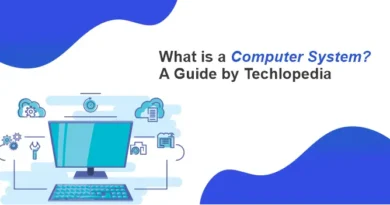What is the Internet of Things (IoT)? A Guide by Techlopedia
The Internet of Things (IoT) is a transformative technology that’s reshaping the way we interact with the world. From smart homes that anticipate our needs to industrial systems that optimize themselves, IoT is revolutionizing both personal and professional landscapes. This guide will delve into what IoT is, how it works, and why it matters. We’ll look into the benefits and challenges of IoT applications.
What is the Internet of Things (IoT)?
The Internet of Things, or IoT, refers to the network of physical objects—“things”—embedded with sensors, software, and other technologies to connect and exchange data with other devices and systems over the Internet.
These “things” can range from everyday household items like refrigerators and thermostats to complex industrial machinery. The key idea behind IoT is to make our world smarter by enabling these objects to communicate, automate tasks, and provide valuable insights through data collection and analysis.
People Also Read: Mastering Google Gemini AI: Top Tips and Best Practices
How Does IoT Work?
IoT integrates devices with sensors and actuators that gather data from their environment. This data is then transmitted to a centralized platform, often in the cloud, where it is processed and analyzed. The processed information can trigger automated actions or provide users with real-time insights.
For example, a smart thermostat can learn your temperature preferences over time and adjust the settings automatically to optimize comfort and energy efficiency. Various technologies, including Wi-Fi, Bluetooth, Zigbee, and cellular networks, typically facilitate communication between devices.
Significance of IoT
The significance of IoT lies in its potential to revolutionize various industries by improving efficiency, reducing costs, and enhancing customer experiences. In healthcare, IoT devices can monitor patients in real time, leading to quicker diagnoses and treatments. IoT sensors can track soil moisture levels in agriculture, optimizing irrigation and improving crop yields.
On a larger scale, IoT can contribute to smart cities, where interconnected systems manage everything from traffic flow to energy consumption, creating more sustainable and livable urban environments.
Benefits of IoT for Organizations
The benefits of IoT are vast for organizations. IoT can improve operational efficiencies by automating routine tasks, reducing manual labor, and minimizing errors. It also enables predictive maintenance by monitoring equipment health in real-time, preventing costly breakdowns and extending the life of assets.
Additionally, IoT can improve decision-making by providing access to real-time data and analytics, allowing businesses to respond swiftly to environmental changes. Furthermore, IoT can enhance customer experiences by enabling personalized services and creating new revenue streams through innovative products and services.
Examples of Consumer and Enterprise IoT Applications
IoT applications span across both consumer and enterprise domains. Smart home devices like Amazon Echo, Nest thermostats, and Philips Hue bright lights are famous examples on the consumer side. These devices simplify daily tasks, enhance home security, and allow users to control their environment through voice commands or smartphone apps.
IoT is transforming industries such as manufacturing, logistics, and healthcare in the enterprise sector. For instance, in manufacturing, IoT-enabled machinery can monitor production lines in real time, ensuring optimal performance and reducing downtime.
IoT can track logistics shipments throughout the supply chain, improving transparency and efficiency. In healthcare, wearable devices monitor patient vitals, allowing remote care and early intervention.
Recommended for You: A Guide on How to Get Meta AI on WhatsApp for Beginners
Pros and Cons of IoT Applications
Here are the Pros and Cons of IoT Applications. Let’s know about them one by one:
Pros
- Efficiency and Automation: IoT can automate processes, increasing efficiency and reducing human error.
- Data-Driven Insights: By collecting and analyzing data, IoT provides valuable insights to drive better decision-making.
- Enhanced User Experience: IoT offers personalized and seamless experiences, from smart homes to connected cars.
Cons
- Security Risks: IoT devices can be vulnerable to cyberattacks, posing privacy and data security risks.
- Complexity: Integrating IoT systems can be complex, requiring significant investment in infrastructure and expertise.
- Interoperability Issues: With a wide range of devices and protocols, ensuring that all IoT components work together can be challenging.
IoT Standards and Frameworks
Various standards and frameworks have been developed for IoT to ensure interoperability and security. Some key standards include the IEEE 802.15.4 for low-rate wireless networks, the MQTT protocol for lightweight messaging, and the CoAP protocol for constrained devices. These standards help ensure that devices from different manufacturers communicate effectively and securely.
Frameworks like the Open Connectivity Foundation (OCF) and the AllJoyn provide guidelines for developing interoperable IoT solutions. These frameworks focus on creating a common language for devices, making it easier for them to collaborate and share data.
Trending on Techlopedia: Learn the Best Way to Organize iPhone Apps with Techlopedia
IoT Security and Privacy Issues
Security and privacy are major concerns in the IoT landscape. As IoT devices collect vast amounts of data, they become attractive targets for cybercriminals. Potential threats include unauthorized access, data breaches, and malicious attacks.
These threats can disrupt services or steal sensitive information. To mitigate these risks, robust security measures, such as encryption, secure authentication, and regular software updates, are essential.
Privacy is another critical issue, as IoT devices often collect personal data without users’ explicit consent. Ensuring that data is handled responsibly and complies with regulations like GDPR is crucial for maintaining user trust and preventing legal repercussions.
The Internet of Things is a powerful technology with the potential to transform industries, enhance daily life, and drive innovation. However, it also comes with challenges regarding security, privacy, and interoperability. As IoT continues to evolve, it will be essential for organizations and individuals to stay informed and adopt best practices to harness its full potential while mitigating risks. With the right approach, IoT can unlock new possibilities and create a more connected, efficient, and intelligent world!



